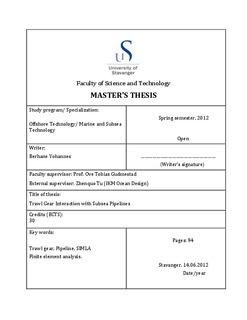| dc.contributor.author | Yohannes, Berhane | |
| dc.date.accessioned | 2012-10-16T12:59:18Z | |
| dc.date.issued | 2012 | |
| dc.identifier.uri | http://hdl.handle.net/11250/183133 | |
| dc.description | Master's thesis in Offshore technology | no_NO |
| dc.description.abstract | This master thesis is written at the University of Stavanger in collaboration with IKM Ocean Design.
The presence of both the fishing industry together with the oil and gas industry offshore results in development of methodologies and techniques on how to exercise offshore activities. It is known that problems can develop when trawl gear interacts with subsea structures like subsea pipelines, manifolds, wellheads, cables and others. Problems resulting from the interaction of trawl gear with subsea structures include safety of vessels, damage to subsea structures and fishing equipment as well as poor communication between the two industries.
One of the most severe design cases for an offshore pipeline system is when there is interaction of fishing gear with a pipeline. Therefore it is important to further understand the behavior of the trawl equipment. Fishing gear weight and velocity as well as pipeline conditions like wall thickness, diameter, coating and flexural rigidity are basic parameters that need to be considered in order to understand the damage to the pipeline and fishing gear during the interference. Realistic description of load level and time history for interaction with a pipeline configuration on the sea bed including free span and pipeline stiffness shall be taken into account during the analysis of the interaction.
The main object of this thesis is to determine pullover loads from commonly and recently used trawl gears on submarine pipelines by using FE assessments. Resulting loads are compared with DNV code recommendations. We contribute towards reducing the conservatism in the design curves through this as we shed light on the expected loads from relatively new trawl gears such as with roller type clump weights. Parameters as trawl gear type, pipeline and seabed soil are investigated in order to understand the significance of the variables and hence derive appropriate design curves based on the significant parameters for DNV-RP-F111 comparisons.
All simulations in this thesis are performed by means of the computer software SIMLA.
Keywords: Trawl gear, Pipeline, SIMLA, Finite element analysis. | no_NO |
| dc.description.sponsorship | IKM Ocean Design Forus | no_NO |
| dc.language.iso | eng | no_NO |
| dc.publisher | University of Stavanger, Norway | no_NO |
| dc.relation.ispartofseries | Masteroppgave/UIS-TN-IKM/2012; | |
| dc.subject | offshore teknologi | no_NO |
| dc.subject | undervannsteknologi | no_NO |
| dc.subject | trawl gear | no_NO |
| dc.subject | piplines | no_NO |
| dc.subject | SIMLA | no_NO |
| dc.title | Trawl gear interaction with subsea pipelines | no_NO |
| dc.type | Master thesis | no_NO |
| dc.subject.nsi | VDP::Technology: 500::Marine technology: 580::Offshore technology: 581 | no_NO |
| dc.source.pagenumber | 94 | no_NO |
